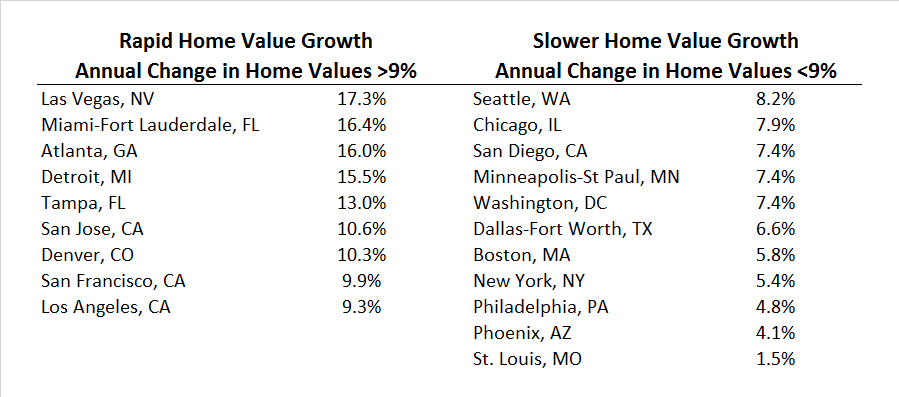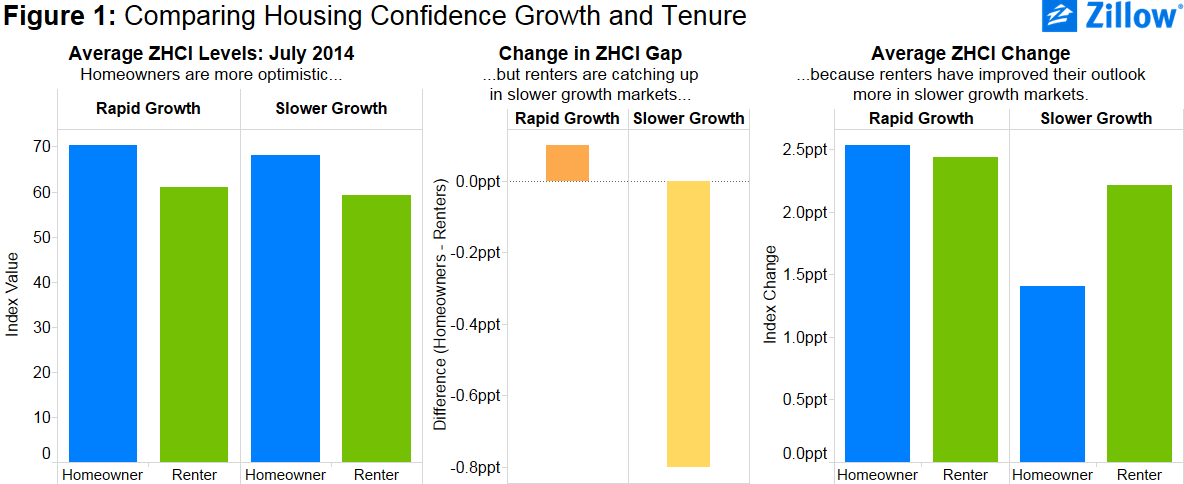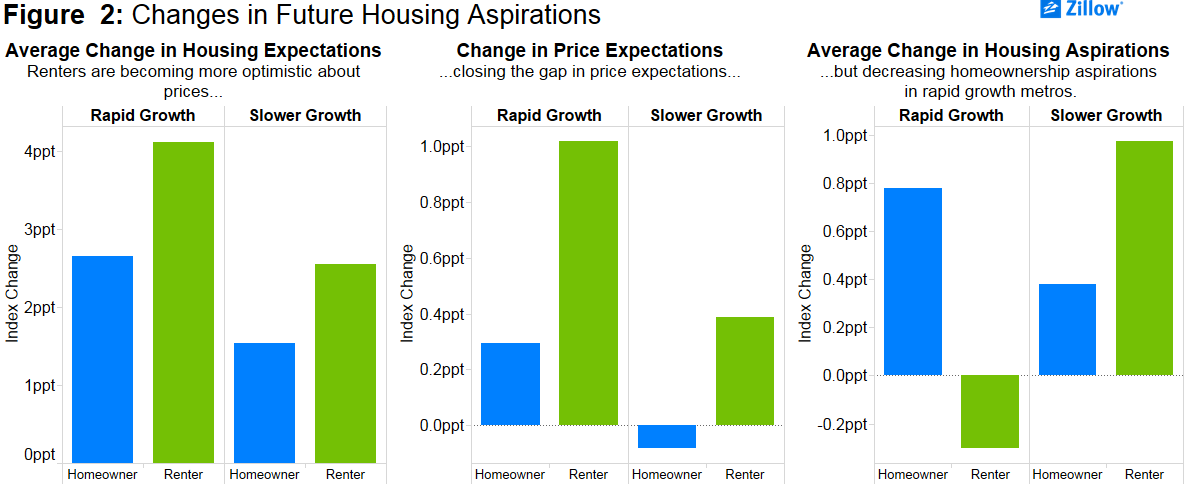- Homeowners are generally more confident than renters in their local housing market’s performance, but this confidence gap is widening in areas with rapid home value growth and narrowing in areas with more restrained growth.
- Homeowners have become more confident about their decision to invest in a home where home values in their area have increased more rapidly.
- By contrast, renters feel that they cannot escape renting and have lowered their aspirations for homeownership in areas where home values have increased more rapidly.
Rapidly rising home values have powerful psychological effects on both homeowners and renters.
Research in behavioral economics has shown peoples’ expectations about the future are strongly anchored in recent experience. Rapid asset price growth can contribute to what has sometimes been labeled “irrational exuberance” – overly optimistic and self-perpetuating positive feedback in price trends.[1] Zillow’s Housing Confidence Index (ZHCI), conducted in partnership with Pulsenomics LLC, provides a unique opportunity to investigate the relationship between recent home value trends and expectations.
Rapid Rise vs. Slow and Steady
The ZHCI is composed of three sub-indices, each of which is calculated separately for renters, homeowners and all residents in 20 metro areas:
- Housing Market Conditions Index, which asks consumers about recent housing market trends in their area
- Housing Expectations Index, which asks consumers about their expectations for home values in their area
- Homeownership Aspirations Index, which asks renters and owners about their hopes and plans for future homeownership
The ZHCI is designed to be a forward-looking measure of housing market health by gauging the beliefs and aspirations of homeowners and renters towards the future state of the housing market. (For more detail, see A Guide to the Zillow Housing Confidence Index.)
 To examine how recent trends in home values have helped shape the views and expectations of homeowners and renters, we separate the metro areas covered by the ZHCI into two groups: Those that have experienced rapid recent home value growth (in excess of 9 percent annually between July 2013 and July 2014, when the survey was last conducted), and those that have experienced more restrained growth (less than 9 percent) over the same period. By this classification, nine metro areas have experienced rapid home value growth (see table).
To examine how recent trends in home values have helped shape the views and expectations of homeowners and renters, we separate the metro areas covered by the ZHCI into two groups: Those that have experienced rapid recent home value growth (in excess of 9 percent annually between July 2013 and July 2014, when the survey was last conducted), and those that have experienced more restrained growth (less than 9 percent) over the same period. By this classification, nine metro areas have experienced rapid home value growth (see table).
In general, the ZHCI (and its sub-indices) is higher for homeowners than for renters (Figure 1, Panel a). This is not surprising since, relative to renters, homeowners typically have higher incomes and a more optimistic perspective about the economy and housing market.
Coming Together, Splitting Apart
But as the economy has improved, the “confidence gap” – the difference between homeowners’ and renters’ confidence index levels – has widened in metros where home value growth has been rapid, and narrowed in metros where home value growth has been more restrained (Figure 1, Panel b).
Homeowners and renters have very similar perspectives on the overall housing market: The ZHCIs for both groups tend to move together. A larger improvement in outlook among renters is the primary driver of converging optimism levels in slow-home value growth markets. But the opposite is true in markets where home values are growing more rapidly. In these markets, optimism levels are diverging (Figure 1, Panel c). Because homeowners’ wealth is largely tied to the value of their home, slower home value growth results in a smaller change in homeowners’ housing market outlook.
In markets where home values are appreciating at a slower pace, renters have become increasingly optimistic about their potential for future homeownership. The Homeownership Aspirations Index, which measures how optimistic owners and renters are about their future homeownership prospects, increased more for renters in slow growth markets than for homeowners (Figure 2, Panel c). But in markets where home values are rising rapidly, renters are becoming increasingly disillusioned, as they likely see the possibility for future homeownership become more inaccessible.
Painting a Picture
These findings can be attributed, in part, to changes in price expectations between renters and homeowners, as can be seen in changes in the Housing Expectations Index. Renters have increased their expectations about future home value growth more than homeowners have, and even more so in rapid growth markets (Figure 2, Panel a). However, homeowners have decreased their expectations about future home value growth in slower growth markets. Even though homeowners have higher expectations for future home values on average, the gap in price expectations is narrowing in both fast and slow-growing markets (Figure 2, Panel b).
These observations paint a unique picture of beliefs about the housing market. Homeowners likely feel that buying a house is a good investment when home values rise, and much more so when home values rise rapidly. Homeowners have a tendency to enjoy high home value growth, because it builds their wealth. Renters, on the other hand, dislike rapid growth in home values, as it likely decreases their view of housing affordability. Renters appear to feel they cannot escape renting – and join the coveted ranks of homeownership – when home values rise rapidly.
[1] On bias due to availability heuristics, see Amos Tversky and Daniel Kahneman, “Availability: A heuristic for judging frequency and probability,” Cognitive Psychology, no. 4 (1973) pp. 207-232. On irrational exuberance, see George A. Akerlof and Robert J. Shiller, Animal Spirits: How Human Psychology Drives the Economy, and Why It Matters for Global Capitalism (New York: Princeton University Press, 2009).

